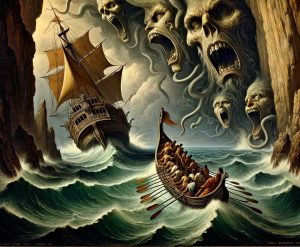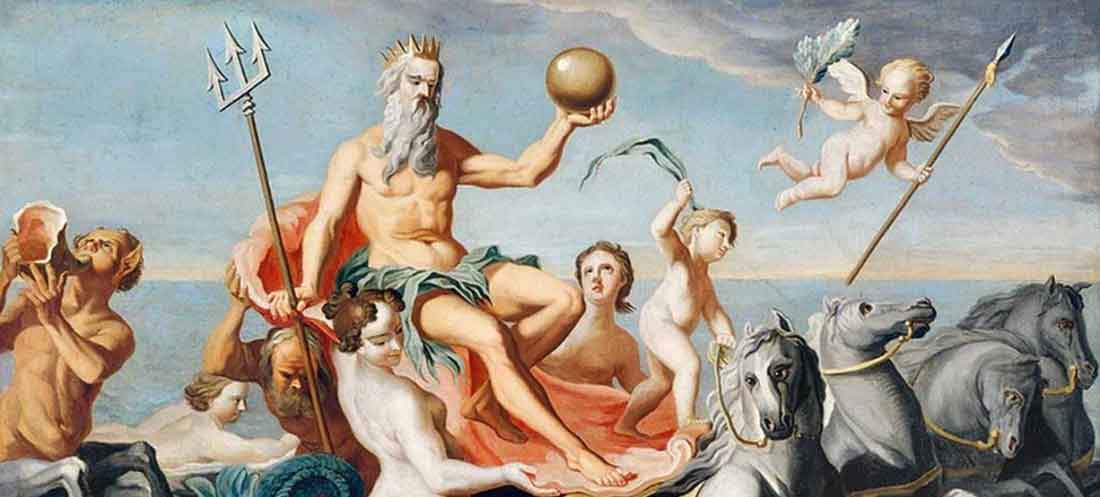The tale of Scylla and Charybdis

Scylla and Charybdis were located close to each other on opposite sides of a narrow strait. Scylla was depicted as a monster with six long necks equipped with grisly heads, each head having three rows of sharp teeth. She would snatch sailors from their ships to devour them. Charybdis was described as a massive whirlpool that would swallow and then vomit out huge quantities of water three times a day, capable of consuming entire ships.
Forewarned by Circe, Odysseus knows he must choose between passing closer to Scylla or Charybdis. Circe advises him to sail closer to Scylla, arguing that it is better to lose a few men to Scylla than to risk the entire ship being swallowed by Charybdis. Following this advice, Odysseus chooses not to tell his crew about Scylla for fear of panicking them. He arms himself and his men in preparation, though he keeps the true nature of the imminent threat to himself.
As they sail through the strait, Odysseus’s ship is indeed attacked by Scylla, who snatches and devours six of his men—one for each of her heads. Meanwhile, Odysseus and the rest of the crew manage to avoid Charybdis, thus preventing the loss of the entire ship. However, the loss of his men deeply distresses Odysseus, marking one of the many sorrows he endures on his journey.
This episode showcases Odysseus’s leadership under extreme pressure and the harsh choices that sometimes must be made. It also illustrates the ancient Greek understanding of navigation hazards and the metaphorical representation of having to choose between two evils, both of which carry significant risk. The passage through Scylla and Charybdis remains a powerful symbol of difficult choices and the dangers that lie in navigating through life’s uncertainties.
The Role of Gods and Goddesses in the Tale
In the epic tale of Odysseus, the role of gods and goddesses is significant. These divine beings intervene in mortal affairs, shaping the hero’s journey with their whims and agendas. Athena, the goddess of wisdom, becomes Odysseus’ ally throughout his trials. Her guidance and protection aid him in overcoming challenges.
On the other hand, Poseidon, god of the sea and earthquakes, holds a grudge against Odysseus for blinding his son Polyphemus. His wrath causes numerous obstacles for our protagonist on his voyage home. The divine interference highlights themes of fate versus free will and showcases how even great heroes are subject to higher powers.
The gods’ influence serves as a reminder that mortals are at the mercy of forces beyond their control. It adds layers of complexity to Odysseus’ quest, illustrating how external factors can shape one’s path in unexpected ways.
Lessons Learned from the Story
The tale of Odysseus and his encounters with the treacherous Scylla and Charybdis holds valuable lessons for us all. One lesson we can draw is the importance of facing our fears head-on, even when the odds seem insurmountable. Odysseus’s bravery in navigating between these two deadly monsters reminds us that courage is key in overcoming obstacles.
Furthermore, the story teaches us about making difficult choices. When faced with two dangerous options, Odysseus had to weigh his decisions carefully and choose the lesser evil. This highlights the need for critical thinking and strategic planning when confronted with challenging situations.
Moreover, Odysseus’s resilience throughout his journey serves as a reminder of the power of perseverance. Despite facing numerous setbacks and dangers, he never gave up on his quest to return home. This resilience inspires us to keep pushing forward in times of adversity.
The story of Odysseus imparts upon us timeless wisdom about bravery, decision-making, and resilience that we can apply to our own lives today.
Modern Interpretations of the Myth
In modern times, the tale of Odysseus facing Scylla and Charybdis continues to captivate audiences across various mediums. From books to movies, artists have reimagined this epic encounter in new and creative ways.
Some reinterpretations focus on the psychological aspect of facing one’s fears or navigating through life’s challenges. Others explore themes of sacrifice, resilience, and the complexities of decision-making.
Contemporary adaptations often highlight the duality of human nature – our capacity for both courage and fear, strength and vulnerability. These interpretations resonate with audiences by portraying characters who must confront their inner demons while overcoming external obstacles.
Through these modern retellings, storytellers breathe new life into an ancient myth, infusing it with relevance for today’s audience. As technology advances and storytelling techniques evolve, we can expect even more innovative interpretations that continue to shed light on timeless truths embedded within this legendary tale.
